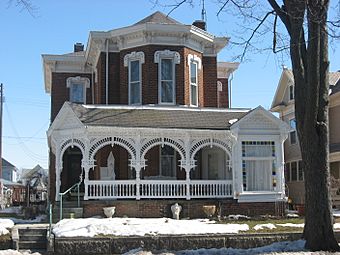Benjamin Franklin Coppess House facts for kids
Quick facts for kids |
|
|
Benjamin Franklin Coppess House
|
|

Front of the house
|
|
| Location | 209 Washington St., Greenville, Ohio |
|---|---|
| Area | Less than 1 acre (0.40 ha) |
| Built | 1882 |
| Architectural style | Queen Anne/Stick-Eastlake |
| NRHP reference No. | 78002052 |
| Added to NRHP | March 10, 1978 |
The Benjamin Franklin Coppess House is a really old and special house in Greenville, Ohio. It was built way back in 1882! This house is famous for its unique style, which mixes two cool types of architecture: Queen Anne and Stick-Eastlake. You can find it at 209 Washington Street.
What Makes This House Special?
The Coppess House has a very fancy front made of brick, showing off its Stick-Eastlake style. It's shaped like the letter "T" and stands on a strong stone base. The roof is made of asphalt, and you can see some other stone parts too.
A big, covered porch and a veranda wrap around the front part of the "T" shape. Above the porch, at the bottom of the "T", there's a large bay window that sticks out.
The porch is one of the most interesting parts of the house. It has super detailed arches made of tiny spindles. These spindles look like they're growing from columns that resemble giant table legs! To get onto the main part of the porch, you walk under one of these arches. There are three more arches on the front and side of the house. Small gables (the triangular parts of a roof) are placed over the main entrance and another smaller one. These gables are decorated with small, carved and molded sculptures.
Why Is This House Important?
In 1978, the Coppess House was added to the National Register of Historic Places. This means it's recognized as a very important historical building because of its amazing architecture. It's one of two special houses on Washington Street, along with the Leftwich House.
Besides its unique porch, the house is also famous for something else inside: its bathroom! People believe it was the very first building in Greenville to have a flush toilet. The person who built this house, Benjamin Coppess, was a farmer and a local government official in Darke County. He was also the grandson of one of the first people to settle in the county.



